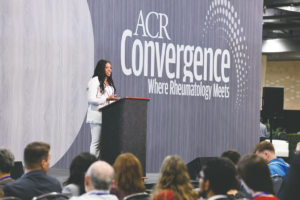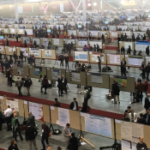 Early in the COVID-19 pandemic, scientific and medical conferences began to be canceled or postponed. Later, once the pandemic endured beyond the scope of weeks to months, many organizations shifted conferences to a virtual format. Now, as the federal government has ended the COVID-19 Public Health Emergency, effective mitigation measures, including vaccination, rapid testing, masking and air filtration, have again made it feasible for most scientists and physicians to attend in-person conferences. However, a newer hybrid conference format has arisen, allowing attendees to choose whether to participate in person or virtually.
Early in the COVID-19 pandemic, scientific and medical conferences began to be canceled or postponed. Later, once the pandemic endured beyond the scope of weeks to months, many organizations shifted conferences to a virtual format. Now, as the federal government has ended the COVID-19 Public Health Emergency, effective mitigation measures, including vaccination, rapid testing, masking and air filtration, have again made it feasible for most scientists and physicians to attend in-person conferences. However, a newer hybrid conference format has arisen, allowing attendees to choose whether to participate in person or virtually.
We discuss the benefits and pitfalls of hybrid conferences, with a focus on equity and inclusion—calling for the continued inclusion of a virtual platform and suggesting ways to optimize that aspect.
Benefits
Inclusion—Virtual options for conference participation improve inclusion of academic faculty and trainees with clinical care responsibilities who cannot travel, relieving tension between attendees and those providing coverage. Busy clinicians without protected conference time can benefit from on-demand access options.
Hybrid meetings enable inclusion of, and engagement with, clinicians in private or community practices who often face financial or logistical obstacles to national and international conference attendance. Virtual conference access provides self-paced academic updates for busy clinicians, which is particularly important for those in private practice—unconnected to academic institutions—who lack protected time for continuing medical education.
Hybrid conferences allow investigators who are parents/caregivers to attend virtually when necessary to meet family obligations. This is particularly pertinent for those in the early stages of their careers, when missing a fully in-person conference may mean missing critical networking opportunities, such as mentor-mentee meetings and subspecialty networking sessions.
Eliminating conference-related travel removes the cost and need for visas, improving accessibility for international attendees who often face long and uncertain visa delays. Sometimes the visa approval process depends on proof of invitation to present or speak at the conference. Even then, if the visa is not approved in time to arrange travel, would-be attendees may have to cancel altogether.
Finally, individuals who face health risks related to travel and/or large in-person gatherings, including clinicians and patients taking immunosuppressive medications, may continue to avoid in-person meetings. This will be a larger issue when community transmission levels of infectious diseases are high, especially as in-person conferences have de-emphasized transmission prevention measures like masking and spacing. A virtual option allows these groups to maintain engagement with the research community without incurring undue health risks. In particular, the inclusion of the patient and caregiver perspective is critical to our field, and providing options to protect their health is essential.
Climate Impact—Attendance at in-person conferences comes with a substantial carbon footprint. Consider the impact of air travel, as well as the manufacture and distribution of single-use items, such as lanyards, booklets and advertisements.1 Life cycle assessment studies suggest a hybrid design can cut a conference’s carbon footprint by up to two-thirds. A recently published comment on the need to reconsider hybrid conferences in light of these environmental costs delves into the issue further.2
Challenges & Potential Solutions
Posters: The poster hall is the hub of the in-person conference. It provides an important networking opportunity and platform to share research, particularly for junior investigators and trainees.
Challenges—Virtual poster halls have proved less successful, with many poster presenters receiving minimal, if any, feedback on their work. With virtual-only poster halls, poster presenters become more reliant on social media advertisement of their work, but many still feel uncertain whether their work has been viewed at all. This limits the power of a virtual poster hall.
Solutions—A browsable central virtual repository for all posters, whether presented virtually or in-person, would allow all attendees the ability to browse posters at their convenience and to network, either by speaking directly with presenters or by leaving comments online. The benefit of maintaining the virtual repository, in addition to the in-person poster hall, is that it allows for increased engagement. Poster tours can be reimagined for the hybrid space, with posters presented as lightning talks for in-person attendees and livestreamed for the virtual audience. In-person attendees, particularly junior faculty and trainees, gain the benefits of in-person networking while virtual attendees are not excluded.
Maintaining virtual access: Virtual access is essential for those who cannot travel. Both livestreaming and on-demand access are important; livestreaming is crucial for engagement with presenters and on social media, while on-demand access facilitates learning when scheduling conflicts make real-time attendance impossible.
Challenges—Both livestreaming and on-demand content require sophisticated, expensive audio-visual capabilities and expertise. Each type of session—livestream vs. on demand vs. in person—requires different involvement from presenters, moderators and participants. Conference organizers may find it difficult to avoid scheduling conflicts between fully virtual sessions and sessions with an in-person component.
Solutions—While this may be expensive, livestreaming is important to create engagement between the presenters and the audience, as well as on social media. Additionally, when registration costs are high, livestreaming is often expected. Clear communication to both presenters and participants prior to conference registration of what material will be livestreamed vs. on demand vs. both is essential. Session moderators need to know whether their sessions will be livestreamed and what responsibilities that entails—most importantly, monitoring an online question-and-answer session to allow full participation for virtual attendees. On-demand access facilitates learning when scheduling conflicts make real-time attendance impossible. Finally, virtual-only sessions are incredibly difficult for in-person attendees, who may struggle to find a quiet place with a stable internet connection to attend virtual sessions that conflict with in-person obligations. Such sessions should be avoided at hybrid meetings or held at a time when they don’t conflict with in-person or hybrid activities.
Financial Considerations
The cost of organizing a hybrid meeting may be higher than an in-person only meeting because specialized audio-visual equipment, a virtual platform, skilled staff and a suitable venue are necessary. Corporate sponsors may have limited interaction with virtual attendees, making hybrid meetings less attractive for financial support. This is complex, and we acknowledge that it may remain a significant barrier, but we hope the benefits of a hybrid meeting encourage continuous problem solving rather than an outright return to fully in-person meetings.
Conclusion
As we emerge from the COVID-19 pandemic, we have the ability to remake the conference experience to maximize engagement in rheumatology research, dissemination of knowledge and connection to the global rheumatology community. The hybrid conference offers the opportunity to cultivate a community and allow rheumatologists and rheumatology professionals to stay connected to research, patient resources and practical clinical teaching. The benefits of the hybrid conference make it a worthwhile experience to preserve.
The authors represent clinicians and researchers, trainees and established practitioners from both the U.S. and other countries.
Disclosures
Professor Richard Conway reports being a member of the speakers bureaus for UCB, Janssen, Roche, Sanofi, AbbVie, Galapagos, Fresenius Kabi and Viatris; undertaking clinical trials funded by AbbVie; and receiving grant/research support from Janssen, Celltrion and Nordic Pharma.
Dr. Laura Lewandowski is the vice chair of the Lupus Committee for the Childhood Arthritis and Rheumatology Research Alliance.
Dr. Noelle Rolle is a member of the Lupus Educator’s Network.
Dr. Grant Schulert has received consulting fees from Sobi (Swedish Orphan Biovitrum AB) and research support from IpiNovyx.
References
- Tao Y, Steckel D, Klemeš JJ, et al. Trend towards virtual and hybrid conferences may be an effective climate change mitigation strategy. Nature Commun. 2021 Dec 16;12(1):7324.
- Nordberg LB, Vikse J, Heiberg MS, et al. Rheumatology congresses post-COVID-19: We cannot regress. Lancet Rheumatol. 2023 Jun 2.
Disclaimer: The views in this article are those of the authors and do not reflect the views of the National Institutes of Health, the Department of Health and Human Services, the U.S. government, CARRA or the ACR.

